



Keeping Garden Chickens in North Carolina - 2
A useful guide to keeping chickens for the hobby farmer from North Carolina State University Cooperative Extension. This second part covers feeding and housing.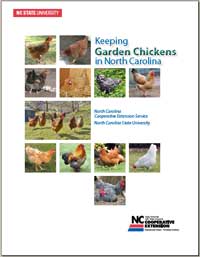
Feeding
When they arrive, your chickens will need to be fed. Fresh feed and water are critical for raising healthy chickens. Feed can be purchased from your local hardware, feed, or farmer's supply store; specialty feeds can be purchased online. Chickens of different ages will need different feed formulations. Chicks raised for egg production will eat starter feed from hatching until eight weeks old, grower feed from eight to 12 weeks old, developer feed from 12 to 21 weeks old, then layer feed from that time on. Place feed for new chicks in shallow troughs. Allow one linear inch of feed trough per chick initially, and increase to two inches per chick after two weeks. A hen will eat about five pounds of feed per dozen eggs produced. Each hen therefore needs about one-third of a pound of feed a day while laying.
The best feed to support an egg-laying hen will consist of about 18 per cent protein. This is the level, you will find in most commercial laying feed pellets or crumbles, or you can mix your own feed to achieve the proper balance. Although hens love mixed scratch grains (cracked corn mixed with other grains), too much will make them fat. Feed no more than ¼ pound of grain per five hens per day. Hens also may be fed table scraps and garden products.
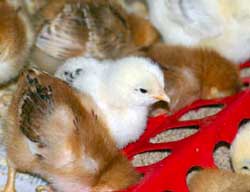
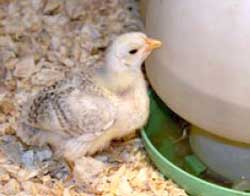
To avoid spoilage and rodents, feed only as many scraps as the hens can consume in 20 minutes or so. You also can supplement your layer feed with range (pasture), or other materials. All hens over one year of age should get a calcium supplement, such as crushed oyster shells, and grit should be made available to all hens.
Keep your chicken feed in a metal can with a tight-fitting lid. Mice and rats will seek out chicken feed and can chew through even the strongest plastic or wood containers. Make sure that there is fresh feed available to your garden hens daily, especially in the early morning and early evening. Birds that are range fed (allowed to forage in the lawn or other areas of the yard) will need supplemental feeding.
Fresh water must always be available for all chickens, of all ages.
Housing
In deciding how many chicks or hens to purchase, you must consider the available space. Chickens should be kept in a confined space for their safety. This space is generally called a coop. The coop is composed of an enclosed, dry shelter and a surrounding fenced, outdoor area. Coops can be simple or elaborate in their design and construction. The following detailed specifications will help you design the actual housing for your backyard flock.
You can keep your hens in something as simple as an old but watertight doghouse, or as fancy as a custom-made hen-house that blends with the architecture of your home, as long as the housing provides sufficient floor space, protection from the weather and predators, ventilation without draughts, a place to roost and nest boxes for laying eggs.
Housing should provide free air movement during hot months, while keeping the hens warm in the winter. It is crucial to ensure that the coop is predator-proof. Predation is the most common cause of mortality in small poultry flocks. Make sure you use a strong wire for your run and that you secure it well to the outside of your upright posts. Wire secured on the inside of the support posts may be pushed in by a persistent predator who wants to gain access to your hens.
A truly predator-proof coop area will include wire buried at least six inches deep around the perimeter of the run. Alternatively, you can bend the wire outward from the spot where the fencing meets the ground and extend it for at least 12 inches across the soil surface, going away from the coop. Secure the wire to the ground with deep landscape staples to keep predators from pushing under the edges.
Finally, for a fully secure run, you will need a wire or solid roof over the entire run area. Designing your coop and run to be long and narrow, like the example below, makes it easier to fully enclose the area. For practical reasons, you may want to consider building your hen house so that the size and shape will allow the building to be used for storage or some other purpose if you decide to stop keeping poultry after a few years.
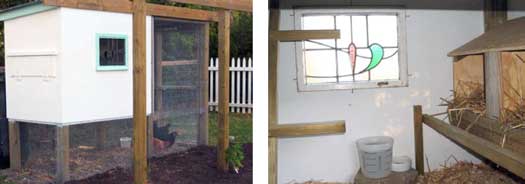
In designing your housing, remember that low-density housing (more space per bird) results in less stress for the birds. Less stress means less pecking and fewer health issues. Consider providing considerably more than the minimum recommended living space per bird, with the opportunity to free range in a grassy area on occasion as well. Allow a minimum of 2.5 to 3.5 square feet per bird inside the weather-tight coop and an additional minimum of 4 to 5 square feet per bird in the fenced, outside area. Cover the floor of the inside, watertight area with about four inches of moisture-absorbent litter, such as wood shavings. Stir the litter often to keep it dry and to prevent caking. Dry sand is a perfect ground cover for the outside run area of the coop.
You may find recommendations for as little as only 1.5 to 2.0 square feet of total coop space for light breeds such as Leghorns or Buttercups, and 2.0 to 2.5 or 3.0 square feet of total coop space for larger, brown-egg laying breeds such as Rhode Island Reds. These recommendations are for large-scale, commercial egg production facilities. Keep in mind that these are the minimum spaces in which the hens can survive and produce eggs. The smaller the space, the more likely it is that your hens will experience stress.
When designing your chicken coop and run, you must consider these species-specific needs: social housing (a chicken should never be left alone, but should be caged with other chickens), laying nests, elevated perches, natural light, and areas for pecking, scratching, and sand or dust bathing. Chickens naturally spend 35 percent to 50 percent of their day scratching and pecking for food. If they do not have an adequate area in which to forage, they tend to peck, pull, and tear at objects or at each other. Be sure that you give your chickens enough space to thrive.
You will need at least one nest box for every four or five hens. The nest box should be located off the floor, inside your weatherproof, enclosed coop area. A nest 12 inches by 14 inches should be large enough for any breed. Nests should be located at the rear of the hen house away from windows, as the hens prefer darker areas for nesting. Each nest should have a board on the front of adequate height to hold in a six-inch deep layer of shavings or straw. Design your coop so that you can easily reach into the nesting box – a hinged door accessible from the outside of the coop works well – to gather eggs and clean the nests.
In addition to the nest space, each bird should have a minimum of nine or 10 inches of perch, or roosting space, within the weatherproof, enclosed housing unit. Make the roosts out of two-inch by two-inch lumber with the upper edge slightly rounded, and place them below the entrance level of the nests, preferably in an area of the enclosed housing that is separate and distinct from the nests. Allow about 14 inches of horizontal distance between perches. For feeding, allow three linear inches of feeder space per bird, and make sure clean fresh water is available at all times.
Many small home flocks are allowed at least some time out of the coop or run to range more freely in grassy areas. If the hens are to be allowed outside of their own fenced, outside run, the ranging area should be fenced, especially if your yard is small and there is any chance the hens will wander off your property. If you plan to allow your hens some time to free range within your fenced yard, consider letting them out within the hour before sunset, as they will naturally return to their coop on their own when the sun goes down. You can just close the door behind them. This is much less stressful for the hens (and for you) than trying to herd them back to their coop after time out in the yard. Hens do not herd well.
Sample Coop Designs
Coops can be small or large, simple or extremely intricate. It is up to you! These plans show a simple, medium-sized coop which, when coupled with an attached run, can readily hold four or five hens and give them plenty of space to nest, roost, and scratch. Note that the coop is elevated to allow a dry, shady spot under the house for the hens to take dust baths. The elevation also allows you to gather eggs and clean out litter without stooping or bending.
To make the attached run, sink posts into the ground at the end of the coop where you find the small entry door for the hens, spacing them just wide enough apart to continue the lines of the coop itself and leaving enough post so that the roof of the coop is high enough that you can easily enter the run while standing upright. Extend the run out at least 6 feet from the coop. Dig a trench at least 10 inches deep along the outside of the new run outline. Your outside wire can then be attached to the posts and buried below ground. This gives you a long, narrow run that is attached to the coop and that protects the hens from ground predators.
The plan includes a full-sized door at the end of the fenced area so you can access the entire pen. The enclosure is just wide enough that you can cover it with a strip of metal roofing or more wire mesh. One of the long sides of the enclosed coop has a hinged, clean-out door, opening flush with the floor, which can be opened to add fresh wood shavings or to clean out spent litter. The other side has a fixed window. Try to position the coop so that the window faces the morning sun to provide plenty of light but not as much heat in the summer.
You can add a small window to the clean-out door as well. One of the short sides has a fixed opening that the hens use to hop in and out of the coop. Attach a roost in the outside run, about 12 inches in front of and just slightly below this door, to ease entry and exit from the coop. The best part of the coop is the long, narrow egg door at the other short side of the coop. This hinges down to reveal two openings, one going into each of the two nesting boxes. You can gather eggs without stepping into the coop or run. In this photo the coop has an attached arbor, which can be used for grapes, kiwi or flowering vines.
Tiny coops with an attached run, designed for two hens, can be purchased ready-made. An opening in the side allows for egg collection, and the whole top pops off so that the inside can be hosed clean. These are expensive, but may be just right for some situations. For something similar but less expensive, an old dog house can be attached to a small covered run, and a PVC and wire day pen can be used to move the hens around the yard for free time.
Coop and run options are unlimited. Design yours to fit your needs and your space.
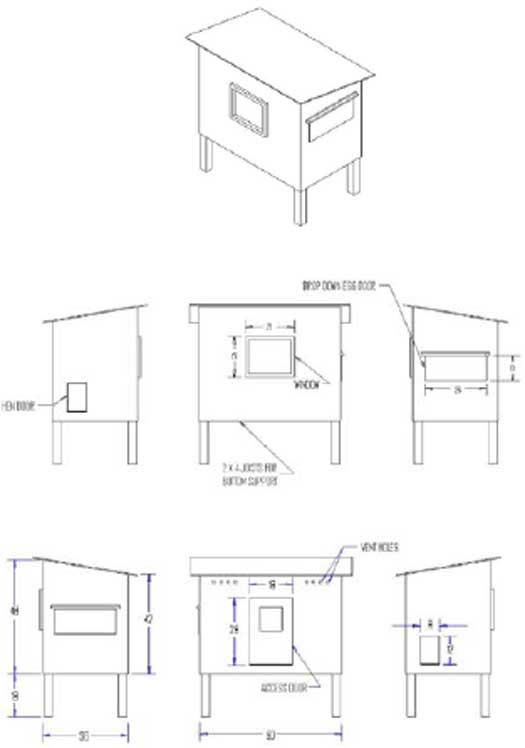
Further Reading
| - | You can view our previous article from this publication by clicking here. |
July 2010








